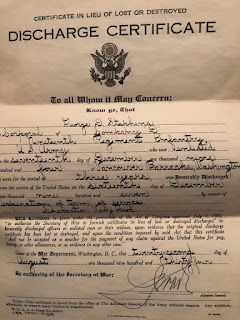 |
| George Day Stephens (Courtesy of Matt Ogle) |
He was a scion of two of Spotsylvania's more prominent families, and his life's work connects him to both my family and topics I have written about for this blog. He grew up in a time in the county's history when most people knew their neighbors intimately, and when a trip to Fredericksburg from Brock Road by horse and buggy probably took the same amount of time that it takes on today's traffic-congested roads.
 |
| Detail of Spotsylvania County, 1863 |
Day Stephens was born at Rose Mount, the Stephens's family home (located on Brock Road at its intersection with the northern outlet of modern Jackson Trail West), the day after Christmas in 1881. He was the sixth of eight children born to John James Stephens (1847-1929) and Lucy Monroe Chancellor (1852-1889). John J. Stephens's father was William A. Stephens, who was a farmer, slave owner, constable, justice of the peace, postmaster at Danielsville, real estate agent and estate appraiser. In 1855, William A. Stephens was one of the appraisers of the estate of his friend and neighbor, my second great grandfather Absalom Row. In the detail of a Civil War-era map shown above, the Stephens farm, Rose Mount, appears in the center of the image. Next to it is Poplar Neck, home to the Trigg family. At the bottom of the image is Greenfield, my family's ancestral home, indicated as "Mrs. Rowe."
 |
| John James Stephens and his second wife, Maria "Nannie" Hackney Stephens (Courtesy of Matt Ogle) |
John James Stephens was the first postmaster appointed to the Wilderness post office after the Civil War. In 1877, he was the first post master named to the post office on Brock Road, established soon after the completion of the Potomac, Fredericksburg and Piedmont Railroad that same year. The next stop of that railroad, which connected Frederickburg and the town of Orange, was Stephens Station. A small building had been built at Rose Mount to accommodate local riders.
Day Stephens's mother, Lucy Monroe Chancellor, was a daughter of Reverend Melzi Chancellor, who served as pastor at Wilderness Baptist Church 1853-1870 (he also served at a number of other local churches during his long career as minister). Lucy died shortly before her 37th birthday, just two years after the birth of her youngest child, Lucy Eleanor Stephens. Her obituary was written by her cousin, Xanthus Xuthus Chartters:
 |
| (Courtesy of Central Rappahannock Heritage Center) |
 |
| (Courtesy of Central Rappahannock Heritage Center) |
Day Stephens lived at Rose Mount until May 1903, when he enlisted in Company D of the 19th U.S. Infantry Regiment. He received an honorable discharge in December 1904 while stationed in the Vancouver Barracks in the state of Washington. He returned to Spotsylvania after his service.
 |
| Day Stephens's discharge certificate (Courtesy of Matt Ogle) |
In 1910, Day was living on the farm of neighbor Thomas E. Faulkner, employed as a handyman. Faulkner was the husband of Isabella Hawkins, whose family's farm was directly in the path of Stonewall Jackson's army as it attacked the exposed Union right flank during the Battle of Chancellorsville. On December 14, 1910, Day Stephens literally married "the girl next door," Josephine "Jody" Trigg (1896-1981).
 |
| Marriage certificate of Day Stephens and Jodie Trigg (Courtesy of Matt Ogle) |
In 1905, Day's oldest brother, Scott Stephens, bought Greenfield from my grandfather's half-brother, Abbie Row. Abbie had gone bankrupt while trying to modernize Greenfield at the same time he was working as a conductor for the Pennsylvania Railroad. This 244-acre remnant of Greenfield, which included the family house and dependencies, was once part of an 889-acre plantation owned by the Rows for 110 years (now a part of Fawn Lake subdivision). Scott owned Greenfield until he died of tuberculosis in 1913. Title to the property passed to another Stephens brother, Robert, who then deeded it to Day, who kept it until 1923.
 |
| Oakley (Frances Benjamin Johnston) |
After the Dobyns family sold Oakley shortly after the Civil War, this historic house was owned by a succession of northerners, few of whom actually lived there. The last of these absentee landlords was Charles A. McHenry, who bought Oakley in 1916. Two years later, McHenry hired Day Stephens as caretaker, a position he held until Oakley was bought by George C. Beals in July 1926.
 |
| Day Stephens (at far right with hat) at Paytes School, about 1913 (Courtesy of Barbara Faulconer) |
Day and Jodie Stephens built a house on Brock Road near old Rose Mount. There they raised their four children: Scott (born 1916), Day Jr., (born 1921), Doris (born 1927) and Sue (born 1931).
 |
| Home of Day and Jodie Stephens (Courtesy of Matt Ogle) |
 |
| Day and Jodie Stephens with their children (Courtesy of Matt Ogle) |
When the Civilian Conservation Corps came to Spotsylvania to create the new national military parks, Day was hired as a foreman at the Chancellorsville site in 1934, a job he held until 1940.
 |
| (Courtesy of the National Park Service) |
George Day Stephens died of a complication of health problems, including heart disease and cirrhosis of the liver, on October 31, 1950.
 |
| George Day Stephens, second from right (Courtesy of Matt Ogle) |
Day was buried at Wilderness Baptist Church on November 2, 1950.
 |
| The grave of George Day Stephens (Courtesy of Matt Ogle) |